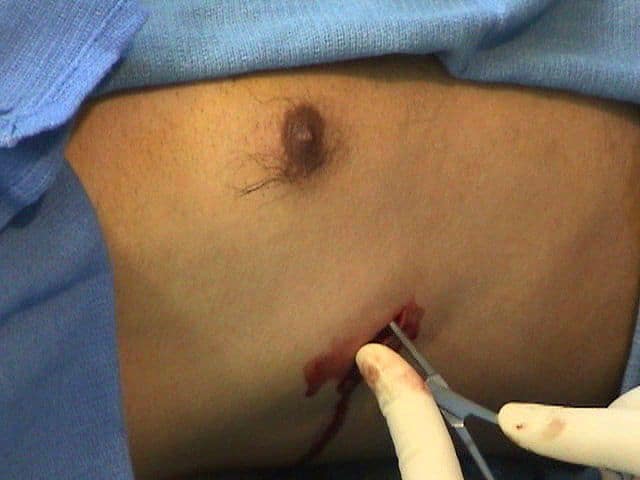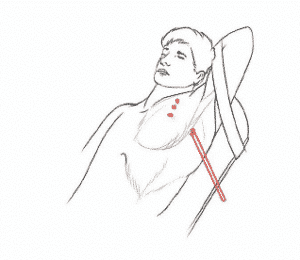
How to Remove the Chest Tube
Chest tubes should be removed when the lung is fully reinflated and there is less than 200-300 mL* non-infected fluid output in 24 hours. Then, briskly remove the chest tube and cover wound immediately with xeroform gauze covered by sterile 4×4 pressure dressings. Also, there appears to be no difference in recurrent pneumothorax if the chest tube is discontinued at end-inspiration or end-expiration.
One study evaluated the outcomes of chest tube removal protocol using digital monitoring of air leak compared to a visual and subjective assessment of air leaks. Results showed that using the digital protocol significantly reduced hospital stay and average cost savings. Chest tube duration also declined as 51% of digital protocol patients had their chest tube removed on the second postoperative day compared to only 12% of traditional protocol patients.
Ultrasound to Guide Chest Tube Removal:
- Linear array probe in longitudinal orientation
- Scan midclavicular line in the first three interspaces
- Water seal for at least 6 hours
- Chest tube could safely be removed if lung sliding, comet tail artifacts in B mode and “seashore sign” in M mode seen at all 3 sites (designated by red circles in figure to the left)
- Repeat bedside ultrasound 4-6 hours after CT discontinuation
- 3.5% PTX recurrence rate

*The timing of chest tube removal based on 24 hour fluid output is not well studied and generally varies based on physician style. Many surgeons feel comfortable removing chest tubes once the daily output of non-infected fluid is <300 mL, but others prefer to wait until the output is <200 mL. One new study even suggests safe to remove when 24h output <400 mL
If you want to know more about this procedure, our courses are available in different modalities and days.
Courses in San Antonio, TX – November 2023
Hospitalist and Emergency Procedures Course: Saturday
Hospitalist and Emergency Procedures Course: Sunday
Hospitalist and Emergency Procedures Course: Weekend
FAQS
When to remove Chest Tube for Pneumothorax?
Chest tubes are typically left in position for a duration that can vary based on individual patient circumstances. Generally, the decision to remove a chest tube hinges on a couple of key factors. When the volume of fluid being drained from the tube diminishes to a minimal level, or when there is no further escape of air through the tube, this often signals that the tube can be safely taken out. As with any medical procedure involving surgical intervention, the primary concerns and potential complications associated with the placement of chest tubes revolve around the risk of bleeding and infection.
Fluid Leaking After Chest Tube Removal. What to Do?
The first step is to assess the situation, the nature and the volume of the fluid loss. It is important to keep the chest tube clean to avoid infection.
Action will depend on the type of fluid. In our courses we will teach you how to act in these emergency cases.
Post Lobectomy Chest Tube Care. Is There a Difference?
The primary goal of chest tube care in this context is to ensure proper lung expansion, prevent complications, and facilitate the healing process. This applies to all procedures.
Drainage After Chest Tube Removal. What to Expect?
It’s perfectly normal to experience a discharge that is thin and either yellow or pink in color from the incision site where your chest tube was removed. To ensure proper healing, it’s recommended that you keep the incision covered with a bandage for a period of 48 hours, which is equivalent to two days. If the bandage becomes wet for any reason, it’s important to replace it promptly.
Resources:
